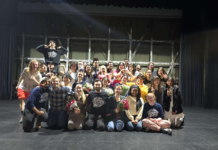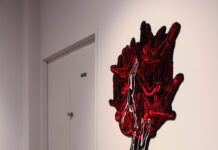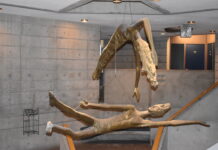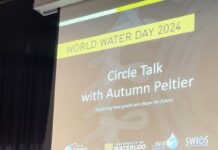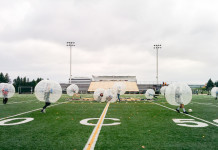The University of Waterloo Art Gallery has kicked off the second exhibit of Season 5, a double header showing works by Zeke Moores and Kelly Jazvac. Respectively titled <em>Dispose </em>and <em>Anthropophotogenic</em>, the artworks in each are deceptive as they function together in the space: at first glance, the gallery appears to be filled with literal garbage.
The majority of works in <em>Anthropophotogenic</em> use found materials such as plastics and refuse from advertising in assemblage-based abstract sculpture, drawing associations between the materials and their implied original state. A particularly interesting component of the exhibit are the <em>Plastiglomerate Samples</em>, a collection of naturally occurring hybrid stones made from plastic melting into natural sand, coral, and volcanic rock. Plastiglomerate was discovered in a collaboration between Kelly Jazvac, geologist Dr. Patricia Corcoran, and oceanographer Charles Moore.
<em>Anthropophotogenic </em>is the perfect companion to the pieces in <em>Dispose</em>, which occupy the main gallery space. Moores’ works are utterly convincing replicas of refuse and industrial materials, hand made from bronze and aluminum. His facsimilies expertly mimic the texture of old wood, cardboard boxes, and even a creased blanket strewn about the floor.
“I think a lot of what I do is about just pointing out the overlooked things in our urban landscape, things that we don’t necessarily take notice of, and trying to highlight those a little bit ... I’m trying to, in a way, monumentalize these kind of mundane objects,” said Moores.
Moores’ choice of subject matter and the subsequent double-take reaction his work elicits forces the viewer to reconsider their associations with everyday objects. Both process and value are subject to this recontextualization; the labour-intensive process and materials involved in producing crumpled cardboard boxes from metal invites viewers to weigh the conceptual value of the objects that make up their environment.
“I’d like for people to see the beauty around them every day. I’d like people to think about the possibility of materials and the value of materials, and to start to look at the world around them in a different way. When it comes to the cardboard boxes, I look at them as snowflakes because they’re all very beautiful and individual in their own way ... but I never really thought about that until I started making them. Now that I make them it’s impossible for me not to see beauty when I walk through an alley or to go to the back of a grocery store...To me it’s about really taking the time to see the beauty that you may not have saw before,” continued Moores.
Despite exploring the transitionary nature of detritus in a materialistic society, neither collection is overtly didactic; though they deal with byproducts of human activity and how they relate to environment, the works avoid explicit cautionary messages and moral ascriptions. “I think environmental concerns are more of an insipid concern, like we know there are things we do daily that are not good for the environment… Yet we do them anyway, and I’m interested in that grey zone,” said Jazvac.
<em>Dispose</em> and <em>Anthropophotogenic</em> are on display at UWAG inside East Campus Hall until Dec. 20.







